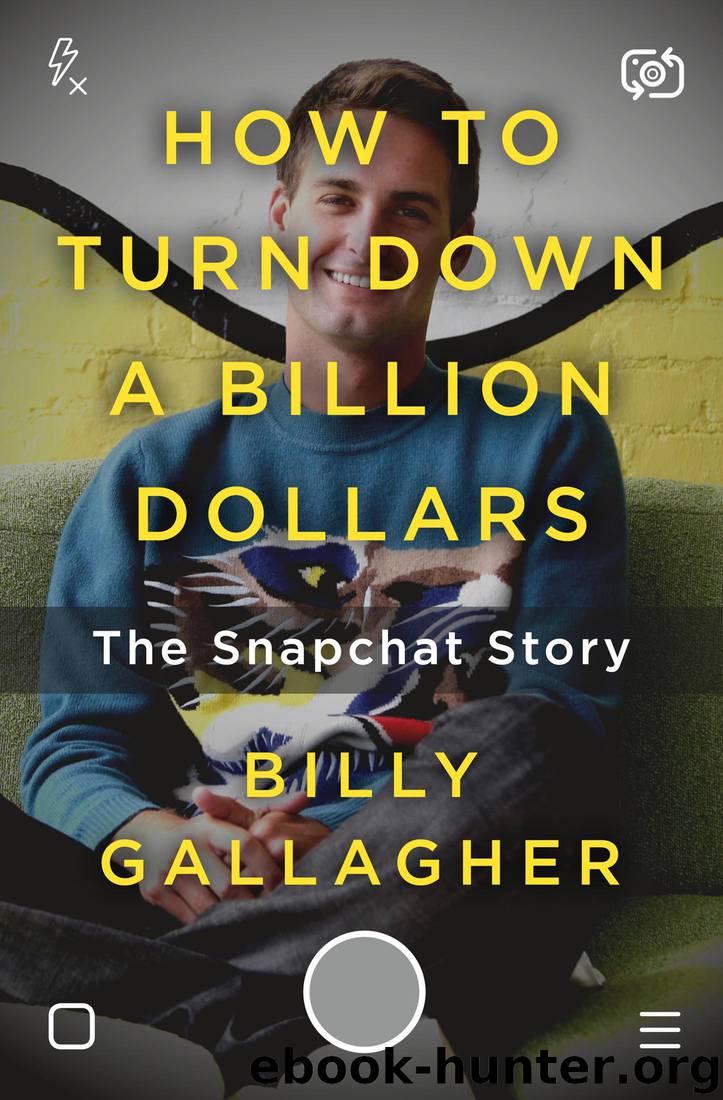How to Turn Down a Billion Dollars by Billy Gallagher

Author:Billy Gallagher
Language: eng
Format: mobi, epub
Tags: business
Publisher: St. Martin's Press
Published: 0101-01-01T00:00:00+00:00
CHAPTER TWENTY-TWO
“WE NEED TO MAKE MONEY”
OCTOBER 2014
VENICE, CA
In 2012, Evan and Bobby had experimented with various ways to make users pay for add-ons and extra features in Snapchat. After going back and forth on the tradeoffs between focusing on growth and making money, they ultimately decided to focus on growth above all else. Evan continued to discuss plans to generate revenue as Snapchat turned down Facebook’s $3 billion acquisition offer; but once again he decided to focus Snapchat’s precious resources on product development, building out Stories, Live, and geofilters.
By 2014, Snapchat was burning over $100 million a year and Evan pushed harder to start monetizing the product. Developing Snapchat into an actual business would put the company on a path toward an initial public offering, a major milestone on the way to achieving Evan’s dream of becoming the most important tech company in the world. Revenue would let Snapchat invest more in future product development; but a bad revenue scheme would piss off users and could hurt both growth and engagement, so they had to be careful.
Evan and Bobby, with their board members Mitch Lasky and Michael Lynton, first looked to Asian messaging companies like Line and the Tencent-owned WeChat, which make money from sponsored messaging and in-app purchases for virtual goods like stickers and games. WeChat lets users subscribe to brands that message them; Line lets users buy virtual stickers (little cartoon drawings depicting mini scenes and emotions) to share with friends.
In August 2014, Mitch Lasky sent Michael Lynton a note quoting a hedge fund manager about Asian messaging companies as the two Snapchat board members debated possible monetization strategies for Snapchat:
It’s using “online” (in Asia primarily mobile) to access goods and services “offline”—good example in US would be something like Uber. But in Asia it’s way way broader. In China people use WeChat to buy stuff like clothes, order food, book travel, pay for taxis, you name it. My partner Matt1 calls it “the mobile phone as the remote control for life.”
It’s an order of magnitude bigger opportunity than advertising and part of the reason I [Mitch Lasky] was so excited about Snapchat’s payment experiments.2 They could be in a unique position to own time-sensitive/ephemeral offers—unsold inventory that expires like tickets to a concert.
Facebook had been positioning Instagram as an advertising property, aligning its crown jewel acquisition with what it did best. Snapchat could potentially lead the way in online-to-offline in the US. In China, people do everything inside one app, WeChat, so operating systems like iOS and Android have much less power. If Snapchat could become a dominant online-to-offline player, it could have much of the platform power that Apple and Google enjoy.
As attractive as this online-to-offline strategy looked in theory, Evan and Bobby weren’t convinced that Snapchat users (primarily in North America and Europe) would behave that similarly to Asian messaging companies’ users. Part of the reason Snapchat was able to succeed in the first place is that Western users explicitly don’t want to use one app for everything.
Download
How to Turn Down a Billion Dollars by Billy Gallagher.epub
This site does not store any files on its server. We only index and link to content provided by other sites. Please contact the content providers to delete copyright contents if any and email us, we'll remove relevant links or contents immediately.
Life 3.0: Being Human in the Age of Artificial Intelligence by Tegmark Max(5405)
The Sports Rules Book by Human Kinetics(4213)
The Age of Surveillance Capitalism by Shoshana Zuboff(4118)
ACT Math For Dummies by Zegarelli Mark(3934)
Unlabel: Selling You Without Selling Out by Marc Ecko(3556)
Blood, Sweat, and Pixels by Jason Schreier(3532)
Hidden Persuasion: 33 psychological influence techniques in advertising by Marc Andrews & Matthijs van Leeuwen & Rick van Baaren(3416)
The Pixar Touch by David A. Price(3331)
Urban Outlaw by Magnus Walker(3305)
Bad Pharma by Ben Goldacre(3208)
Project Animal Farm: An Accidental Journey into the Secret World of Farming and the Truth About Our Food by Sonia Faruqi(3139)
Kitchen confidential by Anthony Bourdain(2969)
Brotopia by Emily Chang(2947)
Slugfest by Reed Tucker(2898)
The Content Trap by Bharat Anand(2837)
The Airbnb Story by Leigh Gallagher(2751)
Coffee for One by KJ Fallon(2518)
Smuggler's Cove: Exotic Cocktails, Rum, and the Cult of Tiki by Martin Cate & Rebecca Cate(2427)
Beer is proof God loves us by Charles W. Bamforth(2342)
